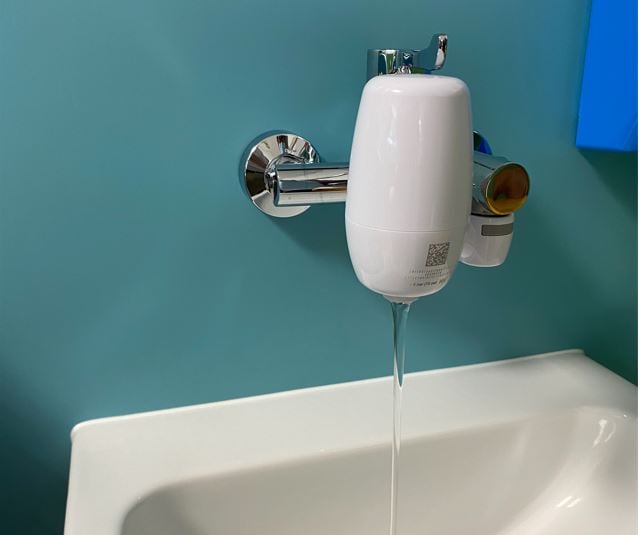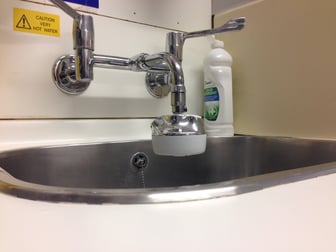
This blog is based on a Healthcare webinar question, however the content on Point of Use Water Filters is a really helpful read for all industry sectors!
Heatlchare Infection Society - IPC Challenges and Solutions
The Healthcare Infection Society [HIS] hosted a webinar on the 29/09/21, the session being part of their ‘IPC challenges and solutions – audience led webinar series’. The format for the webinar being a Q&A session, with no presentations, by a four-person panel of experts answering questions submitted electronically by the audience in advance of the event.
I was asked to be one of the four panel experts, each of the experts were then provided with two questions they had to answer during the session.
These questions were really very interesting to answer, and it makes sense to share them more widely! Part 1 of this blog will focus on one of these questions and the answer provided….
Can a point of use water filter be used as a permanent measure?
"Point of use filters [POUF] are described as a temporary control measure – what happens when you (a hospital) have to utilise these as a long term/permanent measure?"
HTM04-01 Part B provides a helpful and constructive understanding on POUF and their use, so let’s start there….
Point-of-use filtration
7.45 Point-of-use (POU) filtration should be considered and agreed by the Water Safety Group (WSG) only as an interim safeguard where control measures have been ineffective, prior to and during engineering remedial works, during periods of plumbing refurbishments and maintenance works, and where additional protection is required for vulnerable patients. Continuous long-term use of POU filters is not recommended, except where there is no effective alternative. The WSG should review their continued use and ensure an action plan is created and enacted to make certain they are changed at the intervals specified by the manufacturer.
The key element being ‘…where control measures have been ineffective, prior to and during engineering remedial works, during plumbing refurbishments and maintenance works, and where additional protection is required for vulnerable patients.’
Temperature Control
Where control measures have been ineffective could include temperature control (the traditional control strategy), where evidence demonstrates a lack of control i.e. monitoring records showing non-compliant temperatures, and/or Water / Legionella sampling data with positive counts being reported. The reasons why the control measures have been ineffective could be many and varied providing multiple favourable conditions for Legionella proliferation that will need to be identified and then resolved. The resolution will, most of the time, be an engineering fix, e.g., the replacement of an old TMV and tap with a new TMT with integral blender – i.e. a relative quick solution.
Some engineering fixes may require significant input, such as re-piping the water supplies to an area. Until control measures are confirmed to be effective, and the water sampling results are within tolerable thresholds, the use of POUF needs to be reviewed. The removal of POUF should only be when there is confidence in the evidence of sampling data results coupled with system performance data that shows the system is in control.
Noting the combination of these ‘engineering fixes’ would also align with ‘…prior to and during engineering remedial works, during plumbing refurbishments and maintenance works…’
Water Safety Group & Water Safety Plan
 The installation of POUF is to be agreed by the Water Safety Group (WSG), in which case there needs to be a well-defined Water Safety Plan [WSP] that outlines when POUF are required and the associated remedial actions required in response to Legionella positive water sample results. With the development of the WSP guidance from the HSE in the form of HSG274 part 2, HTM04-01 Part B and SHTM04-01 provide details on actions to take with positive microbiological water sample results.
The installation of POUF is to be agreed by the Water Safety Group (WSG), in which case there needs to be a well-defined Water Safety Plan [WSP] that outlines when POUF are required and the associated remedial actions required in response to Legionella positive water sample results. With the development of the WSP guidance from the HSE in the form of HSG274 part 2, HTM04-01 Part B and SHTM04-01 provide details on actions to take with positive microbiological water sample results.
HTM04-01 Part B includes ‘Figure 4: Action levels following Legionella sampling in hot and cold-water systems’. This table details:
- 1000-10000 cfu/l : If a shower (spray outlet) cannot be taken out of use, consider installing point of use microbiological filters on all affected showers.
- >10000 cfu/l : If the outlet cannot be taken out of use, install a point of use microbiological filter on all affected outlets.
POUF do not need to be installed on all outlets in response to positive Legionella sample results. The installation of POUF are an informed decision by the WSG who will be following their WSP which is based on applicable and current guidance.
Conclusion
In answer to the original question, using POUF as an interim safeguard when the system is ‘out-of-control’ the decision to install and use POUF is to be made by the WSG. POUF allows the safe continued use of water, but for how long? Until the root cause of the ‘out-of-control’ condition is resolved.
Depending on the root cause, this ‘how long’ might be weeks / months or longer if the engineering solutions are large and complex.
Feel free to reach out if you have any questions about this blog or if you would like to consult with one of our experts for further advice on water hygiene.
Editor’s Note: The information provided in this blog is correct at date of original publication – October 2021.
© Water Hygiene Centre 2021








